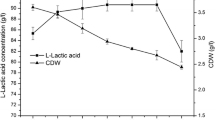Abstract
Strains ofAnaerovibrio lipolytica isolated from sheep- and cow-rumen contents on a linseed oil-rumen fluid-agar medium fermented ribose, glycerol anddl-lactate. Fermentation products from glycerol were propionate and succinate, while ribose, fructose anddl-lactate were fermented mainly to acetate, propionate and carbon dioxide.
Propionate is formed in this organism by the dicarboxylic acid pathway similarly as in propionibacteria.
Measurements of the rate of lipolysis by pure cultures suggest that the organism may play an important role in the lipolytic activity of rumen contents of sheep. The demonstrated fact that the cell-free lipase excreted in the culture medium can easily be adsorbed on particulate matter in autoclaved rumen fluid may explain the absence of free lipase in clarified rumen liquor.
Similar content being viewed by others
References
Baldwin, R. L. 1965. Pathways of carbohydrate metabolism in the rumen, p. 379.In R. W. Dougherty et al., (ed.), Physiology of digestion in the ruminant.—Butterworths, London.
Clarke, D. C. andHawke, J. C. 1970. Studies on rumen metabolism. IV.In vitro hydrolysis of triglyceride and isolation of a lipolytic fraction.—J. Sci. Food Agr.21: 446–452.
Dole, V. P. 1956. A relation between non-esterified fatty acids in plasma and the metabolism of glucose.—J. Clin. Invest.35: 150–154.
Garton, G. A. 1967. The digestion and absorption of lipids in ruminant animals.—World Rev. Nutr. Dietetics7: 225–250.
Garton, G. A., Lough, A. K. andVioque, E. 1961. Glyceride hydrolysis and glycerol fermentation by sheep rumen contents.—J. Gen. Microbiol.25: 215–225.
Hawke, J. C. andSilcock, W. R. 1969. Lipolysis and hydrogenation in the rumen— Biochem. J.112: 131–132.
Hawke, J. C. andSilcock, W. R. 1970. Thein vitro rates of lipolysis and biohydrogenation in rumen contents.—Biochim. Biophys. Acta218: 201–212.
Henderson, C. 1971. A study of the lipase produced byAnaerovibrio lipolytica, a rumen bacterium. —J. Gen. Microbiol.65: 81–89.
Henderson, C. 1973. An improved method for enumerating and isolating lipolytic rumen bacteria.—J. Appl. Bacteriol.36: 187–188.
Henderson, C. andHodgkiss, W. 1973. An electron microscopic study ofAnaerovibrio lipolytica (strain 5 S) and its lipolytic enzyme.—J. Gen. Microbiol.76: 389–393.
Henderson, C., Hobson, P. N. andSummers, R. 1969. The production of amylase, protease and lipolytic enzymes by two species of anaerobic rumen bacteria, p. 189–204.In Proceedings of the Fourth Symposium on Continuous Culture of Micro-organisms, Prague.— Academic Press, London.
Hobson, P. N. andMann, S. O. 1961. The isolation of glycerol-fermenting and lipolytic bacteria from the rumen of the sheep.—J. Gen. Microbiol.25: 227–240.
Hobson, P. N. andMann, S. O. 1971. Isolation of cellulolytic and lipolytic organisms from the rumen, p. 149–158.In D. A. Shapton and R. G. Board (eds.) Isolation of Anaerobes. Soc. Appl. Bacteriol. Tech. Ser. No. 5.—Academic Press, New York and London.
Hobson, P. N. andSummers, R. 1966. Effect of growth rate on the lipase activity of a rumen bacterium.—Nature209: 736–737.
Hobson, P. N. andSummers, R. 1967. The continuous culture of anaerobic bacteria.—J. Gen. Microbiol.47: 53–65.
Hungate, R. E. 1966. The Rumen and its Microbes.—Academic Press Inc., New York and London.
Hungate, R. E., Smith, W., Bauchop, T., Yu, I. andRabinowitz, J. C. 1970. Formate as an intermediate in the bovine rumen fermentation.—J. Bacteriol.102: 389–397.
Kmetec, E. 1966. Spectrophotometric method for the enzymic microdetermination of succinic acid.—Anal. Biochem16: 474–480.
Lanz, W. W. andWilliams, Ph. P. 1973. Characterization of esterases produced by a ruminal bacterium identified asButyrivibrio fibrisolvens.—J. Bacteriol.113: 1170–1176.
Latham, M. J., Storry, J. E. andSharpe, M. E. 1972. Effect of low-roughage diets on the microflora and lipid metabolism in the rumen.—Appl. Microbiol.24: 871–877.
Paynter, M. J. B. andElsden, S. R. 1970. Mechanism of propionate formation bySelenomonas ruminantium, a rumen micro-organism.—J. Gen. Microbiol.61: 1–7.
Paynter, M. J. B. andHungate, R. E. 1968. Characterization ofMethanobacterium mobilis, sp. n., isolated from the bovine rumen.—J. Bacteriol.95: 1943–1951.
Prins, R. A. 1971. Isolation, culture, and fermentation characteristics ofSelenomonas ruminantium var.bryanti var. n. from the rumen of sheep.—J. Bacteriol.105: 820–825.
Rabinowitz, J. L. 1957. Apparatus for wet oxidation of organic samples and carbon dioxide trapping for subsequent radioactive assay.—Anal. Chem.29: 982–984.
Sakami, W. 1955. Handbook of isotope tracer methods.—Cleveland, Ohio, U.S.A.: Western Reserve University.
Sierra, G. 1957. A simple method for the detection of lipolytic activity of micro-organisms and some observations on the influence of the contact between cells and fatty substrates.— Antonie van Leeuwenhoek23: 15–22.
Smith R. F. andWillett, N. P. 1968. Lipolytic activity of human cutaneous bacteria.— J. Gen. Microbiol.52: 441–445.
Trout, D. L., Estes, E. J., Jr. andFriedberg S. J. 1960. Titration of free fatty acids of plasma: a study of current methods and a new modification.—J. Lipid Res.1: 199–202.
Wright, D. E. 1969. Fermentation of glycerol by rumen microorganisms.—New Zealand J. Agr. Res.12: 281–286.
Author information
Authors and Affiliations
Rights and permissions
About this article
Cite this article
Prins, R.A., Lankhorst, A., van der Meer, P. et al. Some characteristics ofAnaerovibrio lipolytica, a rumen lipolytic organism. Antonie van Leeuwenhoek 41, 1–11 (1975). https://doi.org/10.1007/BF02565031
Received:
Issue Date:
DOI: https://doi.org/10.1007/BF02565031




